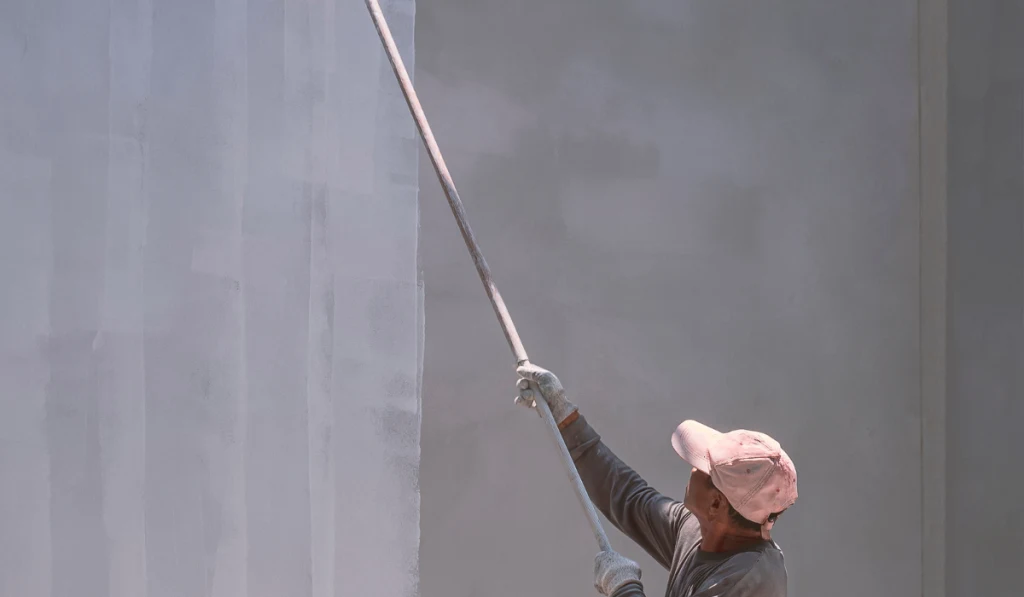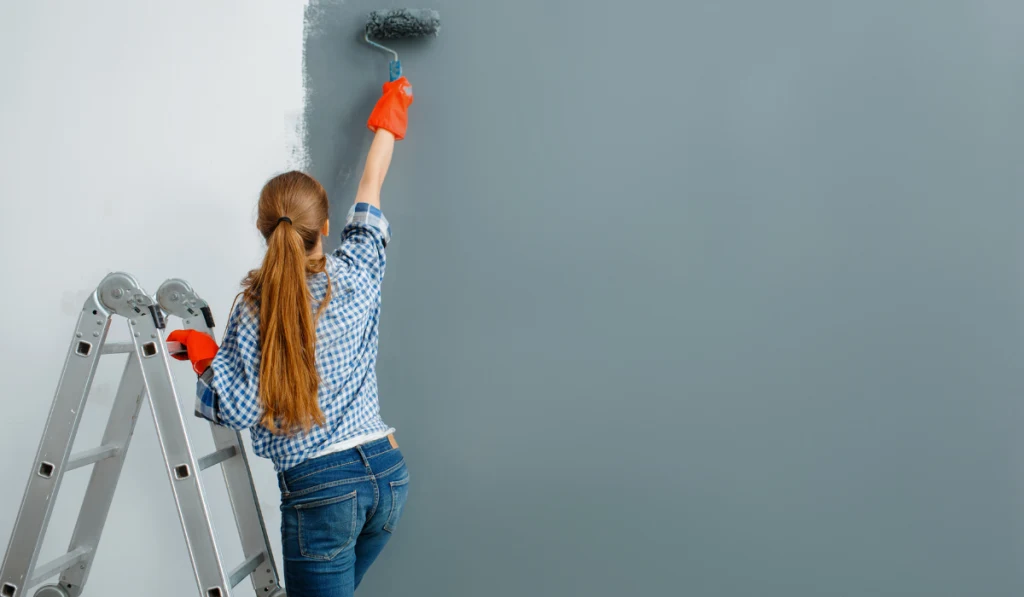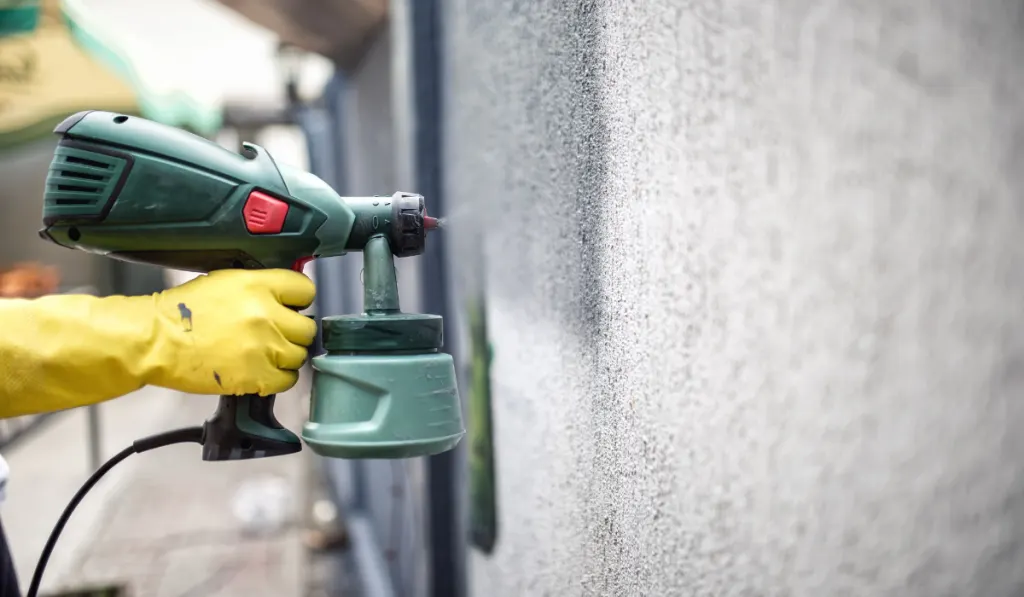Concrete blocks, or cinder blocks, are affordable and easy to use.
In addition, they’re incredibly durable, which is why so many people use them for sheds, walls, commercial buildings, and storage facilities.
Gray or natural cinder blocks are common to see because they’re challenging to paint, especially when you’re painting them outside.
They also suck up a lot of moisture, which makes it hard for the paint to settle nicely.
With the right tools and following specific steps, you can turn your cinder blocks from something drab to beautifully colorful. That new color you choose can last for years and add curb appeal.
Whether you’re painting the outside of a garage or your storage shed in the backyard, here are nine tips you can use to make your project a success.
1. Give Your Concrete Blocks a Power Wash First

You can skip this step if your concrete wall is brand new. Otherwise, a power wash before you start painting is a must.
When concrete blocks are outside, they have a habit of collecting leaves, moss, sap, and a lot of other debris.
Most of that debris is sticky and will require a good scrubbing before you paint. Painting over the debris will make the color look uneven and affect how well it sticks to the surface.
In addition, it’s more likely that the paint will run, and the blocks will have trouble absorbing the paint.
Thankfully, power washers are relatively affordable, especially if you look for a used one on local listings for sale in your area.
You can also pay a company to power wash your concrete block walls before you start painting.
2. Wait Until the Walls Are Completely Dry
Never paint a wet surface.
You need to wait until the wall is washed and completely dry before you start putting on paint or primer.
Painting when a concrete wall is wet makes it harder to spot areas that need more paint or where the paint is too thick.
It also affects absorption. The paint may go deeper into the pores of the concrete as the blocks dry.
3. Check the Weather First

Check the weather forecast in your area before you begin painting.
This will help you avoid painting in a storm or dealing with humid weather that will make the paint take much longer to dry.
Instead, give yourself at least a few days of dry, clear weather for your project, so you’ll have enough time to let things dry and finish the painting before the next rainfall.
If you do encounter rain in the middle of your project, stop what you’re doing and wait for the weather to clear.
There’s no sense in trying to work while it’s raining intermittently because the paint won’t dry, and it will run if there’s water on the wall.
4. Address Cracks Before Painting
If your concrete block wall has been around for a while, you likely have cracks in some of the blocks.
Tiny hairline cracks are no big deal, but you’ll need to address larger cracks where the paint will seep inside.
Using a caulking gun and caulk, run over any cracks to fill them. Have a putty knife handy to smooth out caulk lines and make them even with the wall’s surface.
Allow time for the caulk to dry before you paint.
5. A Primer Coat Is Essential

Regular exterior paint won’t adhere well to masonry work.
Cinder blocks absorb the paint unevenly, leaving you with unwelcome paint splotches all over your walls, depending on how thick you cover things.
A primer coat is essential when painting something like brick or concrete block walls.
The primer goes into all of the pores and seals them, so when you paint, the paint stays on the surface instead.
When you apply the primer, use a roller, and put it on in a thick layer. Usually, one primer layer will do, but you can use two layers to be sure your wall is ready for painting.
6. Choosing the Right Paint
When painting concrete block walls outside, the type of paint you choose is crucial to the project’s success. Usually, premium acrylic latex paint is the best option for outdoor surfaces.
Latex paint is thick and adheres to the primer very well. It also provides a smooth finish after you’re done.
When in doubt, visit your local hardware store and ask for some advice on which paint to choose. They can typically make you a custom color, so that’s not much of an issue.
Decide what type of paint you need first, and then work to get the color you want.
7. Apply At Least Two Coats of Paint

You’ll probably need at least two coats of paint when you paint concrete blocks.
No matter how much primer and caulk you use, masonry products, like concrete blocks and bricks, are incredibly absorbent. They’ll suck up a lot of your paint, making the color look uneven.
Put on the first coat of paint and let it dry for several hours.
Remember, painting outdoors is different than painting the bedrooms in your house. You usually need more time for things to dry.
Keep applying coats of paint until you’re satisfied with the color.
8. Work From Top to Bottom
Painting from top to bottom is your best bet.
Starting at the top of a concrete block wall means any drips will flow down into lower areas of the wall instead of the ground.
The last thing you want is a bunch of blue (or whatever color you’re using) grass and dirt under your wall. Consider laying down a sheet or cardboard to catch any running paint or spills.
9. Spraying Is a Good Option for Exterior Walls

Spraying the paint on exterior concrete block walls is often wise because it helps things look even. With spraying, you get a nice coat of paint without splotches.
Spraying is also a lot faster, especially if you know how to use the machine. If you aren’t familiar with a paint sprayer, you can hire a professional and pay someone to do it.
They’ll have experience painting exterior walls and know how many coats are needed for a great finished product.
They’ll also work much faster and avoid some of the spills and other mistakes common with DIY painting projects.
In Closing
Painting outdoor concrete walls is challenging, but color always makes the concrete look better than if it’s bare.
With the right tools and a good plan, you can transform your concrete blocks into something you enjoy looking at and that adds to your property value.
